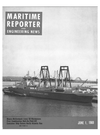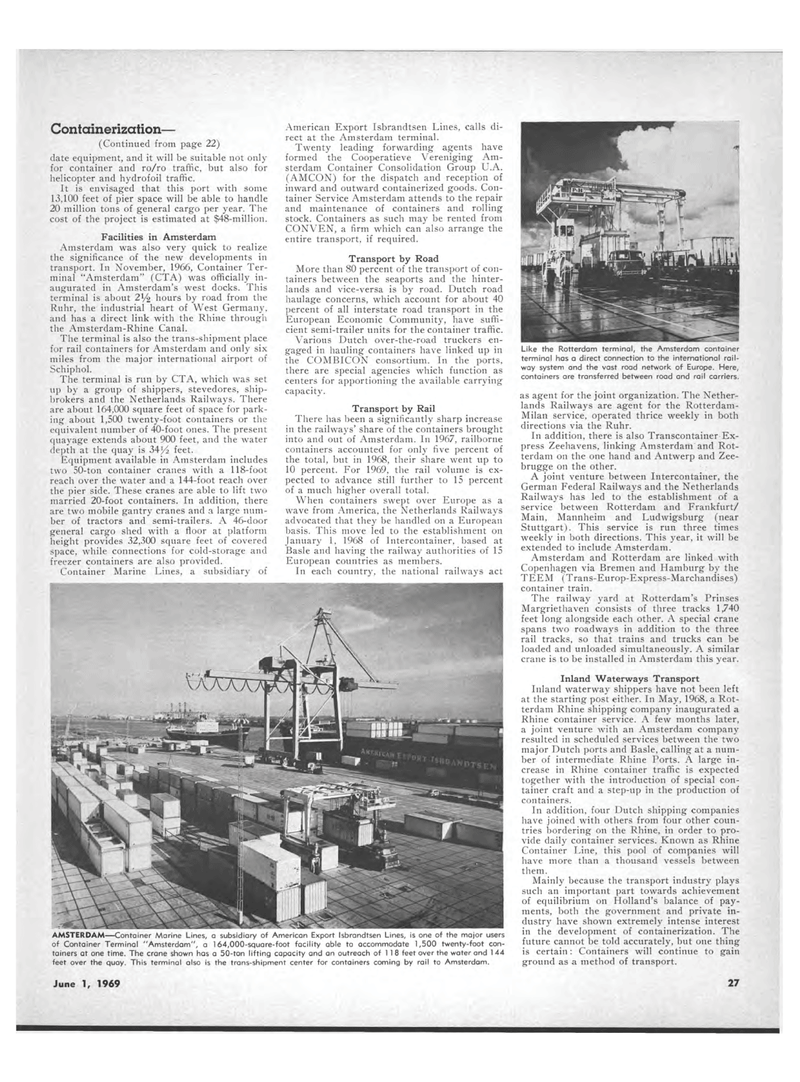
Page 25: of Marine News Magazine (June 1969)
Read this page in Pdf, Flash or Html5 edition of June 1969 Marine News Magazine
Containerization? (Continued from page 22) date equipment, and it will be suitable not only for container and ro/ro traffic, but also for helicopter and hydrofoil traffic. It is envisaged that this port with some 13,100 feet of pier space will be able to handle 20 million tons of general cargo per year. The cost of the project is estimated at $48-million. Facilities in Amsterdam Amsterdam was also very quick to realize the significance of the new developments in transport. In November, 1966, Container Ter-minal "Amsterdam" (CTA) was officially in-augurated in Amsterdam's west docks. This terminal is about 2!/2 hours by road from the Ruhr, the industrial heart of West Germany, and has a direct link with the Rhine through the Amsterdam-Rhine Canal. The terminal is also the trans-shipment place for rail containers for Amsterdam and only six miles from the major international airport of Schiphol. The terminal is run by CTA, which was set up by a group of shippers, stevedores, ship-brokers and the Netherlands Railways. There are about 164,000 square feet of space for park-ing about 1,500 twenty-foot containers or the equivalent number of 40-foot ones. The present quayage extends about 900 feet, and the water depth at the quay is 34^ feet. Equipment available in Amsterdam includes two 50-ton container cranes with a 118-foot reach over the water and a 144-foot reach over the pier side. These cranes are able to lift two married 20-foot containers. In addition, there are two mobile gantry cranes and a large num-ber of tractors and semi-trailers. A 46-door general cargo shed with a floor at platform height provides 32,300 square feet of covered space, while connections for cold-storage and freezer containers are also provided. Container Marine Lines, a subsidiary of American Export Isbrandtsen Lines, calls di-rect at the Amsterdam terminal. Twenty leading forwarding agents have formed the Cooperatieve Vereniging Am-sterdam Container Consolidation Group U.A. (AMCON) for the dispatch and reception of inward and outward containerized goods. Con-tainer Service Amsterdam attends to the repair and maintenance of containers and rolling stock. Containers as such may be rented from CONVEN, a firm which can also arrange the entire transport, if required. Transport by Road More than 80 percent of the transport of con-tainers between the seaports and the hinter-lands and vice-versa is by road. Dutch road haulage concerns, which account for about 40 percent of all interstate road transport in the European Economic Community, have suffi-cient semi-trailer units for the container traffic. Various Dutch over-the-road truckers en-gaged in hauling containers have linked up in the COMBICON consortium. In the ports, there are special agencies which function as centers for apportioning the available carrying capacity. Transport by Rail There has been a significantly sharp increase in the railways' share of the containers brought into and out of Amsterdam. In 1967, rail-borne containers accounted for only five percent of the total, but in 1968, their share went up to 10 percent. For 1969, the rail volume is ex-pected to advance still further to 15 percent of a much higher overall total. When containers swept over Europe as a wave from America, the Netherlands Railways advocated that they be handled on a European basis. This move led to the establishment on January 1, 1968 of Intercontainer, based at Basle and having the railway authorities of 15 European countries as members. In each country, the national railways act Like the Rotterdam terminal, the Amsterdam container terminal has a direct connection to the international rail-way system and the vast road network of Europe. Here, containers are transferred between road and rail carriers. as agent for the joint organization. The Nether-lands Railways are agent for the Rotterdam-Milan service, operated thrice weekly in both directions via the Ruhr. In addition, there is also Transcontainer Ex-press Zeehavens, linking Amsterdam and Rot-terdam on the one hand and Antwerp and Zee-brugge on the other. A joint venture between Intercontainer, the German Federal Railways and the Netherlands Railways has led to the establishment of a service between Rotterdam and Frankfurt/ Main, Mannheim and Ludwigsburg (near Stuttgart). This service is run three times weekly in both directions. This year, it will be extended to include Amsterdam. Amsterdam and Rotterdam are linked with Copenhagen via Bremen and Hamburg by the TEEM (Trans-Europ-Express-Marchandises) container train. The railway yard at Rotterdam's Prinses Margriethaven consists of three tracks 1,740 feet long alongside each other. A special crane spans two roadways in addition to the three rail tracks, so that trains and trucks can be loaded and unloaded simultaneously. A similar crane is to be installed in Amsterdam this year. Inland Waterways Transport Inland waterway shippers have not been left at the starting post either. In May, 1968, a Rot-terdam Rhine shipping company inaugurated a Rhine container service. A few months later, a joint venture with an Amsterdam company resulted in scheduled services between the two major Dutch ports and Basle, calling at a num-ber of intermediate Rhine Ports. A large in-crease in Rhine container traffic is expected together with the introduction of special con-tainer craft and a step-up in the production of containers. In addition, four Dutch shipping companies have joined with others from four other coun-tries bordering on the Rhine, in order to pro-vide daily container services. Known as Rhine Container Line, this pool of companies will have more than a thousand vessels between them. Mainly because the transport industry plays such an important part towards achievement of equilibrium on Holland's balance of pay-ments, both the government and private in-dustry have shown extremely intense interest in the development of containerization. The future cannot be told accurately, but one thing is certain: Containers will continue to gain ground as a method of transport. AMSTERDAM?Container Marine Lines, a subsidiary of American Export Isbrandtsen Lines, is one of the major users of Container Terminal "Amsterdam", a 164,000-square-foot facility able to accommodate 1,500 twenty-foot con-tainers at one time. The crane shown has a 50-ton lifting capacity and an outreach of 1 1 8 feet over the water and 1 44 feet over the quay. This terminal also is the trans-shipment center for containers coming by rail to Amsterdam. June 1, 1969 27

 24
24

 26
26
